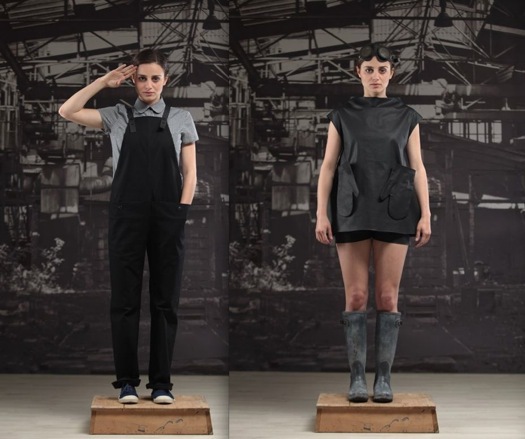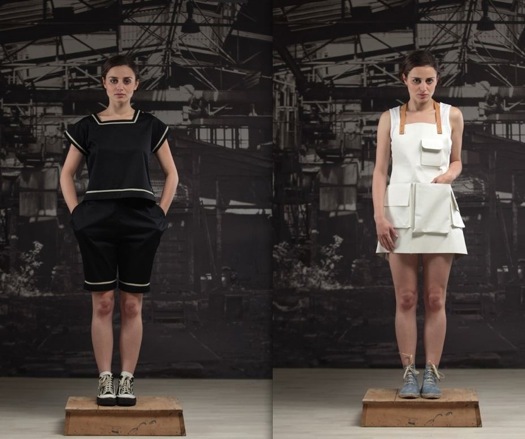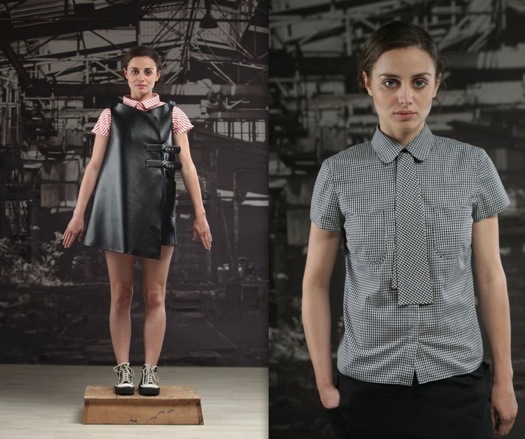
Rodchenko Worksuit (£220) and Safety Mittens Top (£140), part of new Comradettes collection
Experience has taught Eldina Begic much about ideology. Born in Sarajevo, the 34-year-old designer witnessed the political transformation of former Yugoslavia, the conflict that followed, and the siege of her native city, before moving to London in 2000. Says Begic: “I have lived in a liberal Communist country, a country at war, a country after war — and now I am living in the heart of capitalism.”
It’s a background of extreme contrasts that inspired her latest creation: a 20-piece collection of women’s clothing, shown for the first time in London last week. The goal: to celebrate the "socialist work culture" of her childhood and to challenge the individualism that characterizes the fashion that Begic finds in today’s Britain.
In particular, Begic wants to send a message about a lost "sense of solidarity" and "community" through her Comradettes range. “It is the very opposite of fashion and the design industry, which are all about seasonal changes and creating one-off pieces. What I want to do is to explore the idea of uniform and work clothes and use it for propaganda.”
 Marine Suit (£185) and Multi-Pocket Apron (£80)
Marine Suit (£185) and Multi-Pocket Apron (£80)For the designs of her "productivist worksuits," she has drawn on constructivist style and her own research into the workwear of Eastern Europe and South America. The collection makes heavy use of hard-wearing fabrics to create, for example, cotton dungarees and overalls as well as jackets of rubberized cotton and a smock of stiff artists’ canvas.
The opening show made plain the back-to-basic theme: no catwalk or models, just a rack of clothes in an open wardrobe on the floor of a former factory with a pile of hammers as the only decoration. Slogans on the outside walls proclaimed: “Revolution is Glorious,” “Down with Luxury” and “Dress for Revolution.”
But the Comradettes range aspires to an elegance never seen on the factory floor. Begic’s heavily stylized interpretation of working class clothing has little to do with the rough and ready outfits of heavy industry. Each piece is tailor made, and she takes pride in the high quality of the workmanship. “My mother worked as a tailor for 42 years. I don’t have single piece of clothing that came from a shop.”

Welding Dress & Waistcoast (£165) and Everything Shirt With Tie (£110)
For Begic it’s a first venture into clothing — she dislikes the word "fashion." In the past, she’s designed innovative retail outlets for a range of high-profile clients from Levi’s to Nike and Save the Children. But she likes to stress that her real enthusiasm is for the conceptual rather than the strictly practical. “I see this just as an interesting way of using a particular medium.”
Isn’t there a risk that Comradettes will be seen as no more than boho chic, a sentimentalized interpretation of an uncomfortable past for today’s rich? In time, Begic hopes that some of the items may be mass produced to bring down the cost, but for now prices aren’t likely to attract Main Street buyers. Says Begic: “I can’t do anything about the prices but what I can do is influence people’s opinions and, hopefully, their values.”


Comments [8]
I would have thought a progressive celebration of socialist work culture would involve engaging with alternative kinds of work and exchange practices, and creating the material equipment (including clothes) to support this. I would not have thought it was about re-representing/selling anachronistic iconography.
The worst part is the pretense to generating solidarity and community. Around what exactly? Wearing ‘socialist’ clothes? If this was supposed to be a political move it rings pretty hollow.
I think the most interesting thing is the material quality of the clothes. If this was about developing new practices of purchase, use, and care for quality clothes that are designed to help people in their contemporary work activities, then it would be interesting. Otherwise I cant see past this being a sophisticated gimmick.
06.30.11
12:37
It's certainly easy to fetishize the aesthetics of Constructivist and socialist visual production -- the pieces displayed here look great -- but the further claim that this collection embodies, enables, or otherwise advances the laudable aims of solidarity and community indeed rings hollow.
06.30.11
08:28
06.30.11
08:34
You says it's "inaccessible both in terms of concept and price" - if you think the concept is inaccessible then you probably don't credit people with very much intelligence. And this is far from being a "gimmick" - these clothes are exceptionally well made.
So let me explain. Regarding the price: We are use to high street prices, but they reflect exploitation of labour in India or Vietnam or other developing economy. And the quality of those clothes is appalling, they're simply not meant to last. People have got used to an unsustainable, disposable, exploitative fashion market.
Making bespoke tailored clothes is an entirely different process and the cost is higher. I've made every effort to keep the price as low as possible but I'm not in control of the economics here. These clothes are not mass-produced, and thus don't have mass-production prices. However, compared to any tailored clothes - in the UK at least – they are incredible value.
My target is not the poor. To target the poor I would need to have huge investment and produce the clothes in a developing economy, exploiting the poor in turn. My logic is that poorer people aspire to be more like wealthier people. In that sense my clothes are a form of design propaganda. If wealthier people can appreciate well-made workwear, then the poor need not feel bad about their own clothes. I want people rediscover pride in being workers. At every turn, the UK government (for example) prioritises the livelihoods and welfare of the rich, of the bankers, while making the worker majority bear the brunt of its austerity measures. That's just one example of how warped our social values have become.
Regarding the design: Yes, the clothes are designed like a tools- to be functional, versatile and practical, but also it was important to me that they be well cut and that they fit well. We live multitasking lives, and we don’t have time for “occasional” clothes - one moment I’m making a prototype in my workshop, the next I’m going on a building site, to an office meeting, cycling or attending an event in the evening. I need my clothes to be good for all this.
There is no "iconography" - these are just good clothes!
06.30.11
02:42
FYI-Those were Wendy's ads done by Joe Sedelmeier from the mid-80's
06.30.11
03:27
06.30.11
05:14
Thank you very much for the reply. I really appreciated reading your response. The problem of producing quality clothing in the existing economic climate is something I have a lot of sympathy for. But there are a couple of other points to consider in what has been said.
The ‘feminised’ comment was one part of a general observation that this work does reflect aspects of a conventional fashion industry approach to clothing. ‘Femininity’ is a concept fraught with complexity but I certainly mean more than simply ‘for women’ (there are plenty of women who are proudly un- or alter-feminine). To be more precise, perhaps I’m trying to say that elements of this work reflect a ‘fashionised’ form of femininity.
On conceptual inaccessibility, this has almost nothing to do with intelligence. It is about sociality – how taste fuses with education and social advantage. To fully understand your work your audience needs a level of background knowledge on design, industrial, economic, and European history. This is not general or everyday practical knowledge. It is only stuff you know if you were lucky enough to learn it from somewhere. Those that don’t have this knowledge, most likely because they or others never though it was in their interest to learn it (‘I want to be a builder, what the hell do I need to know about funny shaped clothes?’), are conceptually excluded from this work. There is a lot of misrecognition in high design/art circles of the huge amount of cultural capital needed to access conceptually based work (see Bourdieu’s ‘Distinction’), including in this case when you are clearly drawing upon the visual language (iconography: image writing) of an historical movement.
I’m afraid the ‘design propaganda’ also feels more like sophisticated marketing. Otherwise its an extremely muddled politics. I’m sure plenty of wealthy people with the right cultural background will be attracted to the clothes, as will quite a few who are not that wealthy (I like the look of a few myself). But you are creating neither workwear nor politics. Even if we ignore the fact that a significant proportion of contemporary work is white-collar, blue-collar workwear does not look 20th cent. constructivist, it looks like this: (http://www.hardyakka.com.au/shirts/products). As such I don’t understand how people are supposed to identify with, and valorize their work by seeing wealthy/stylish people wearing quirky clothes. At best I think it invites, ridicule, at worst, envy. It seems you are expecting people to see their disadvantage, collectivity, and undeservedness (sparking political action) reflected in the image of social advantage. But this is one of the reasons why we have mass (exploitative) production – so desire and social tastes can be delivered cheaply. As member of the creative class you have (re)created a style typology that will be copied if it proves popular. While I’m sure some of the clothes have practical affordances, it has to be said that they are presented, and will be read, as symbolic objects, and this symbolism is very easy to materially undermine (a good paper on this issue: http://bit.ly/iKk7Cb).
But while I think the politics is antiquated and half-baked I think there is a tremendous amount of value in what you and other highly skilled, quality craftspeople do. I think that a fair and sustainable economy has to be one that reflects a concern with quality (of materials, workmanship, durability, renewability, care, relationships etc) over quantity (faster, cheaper, more, newer). In this sense I think the ultimate target must be economic reform pushed by people like yourself who know and can demonstrate the value of quality. The heart of my critique here is that I think the symbolic coding of the work is wrong. An alternative tact is harder to design and enact, but I think it is necessary. I hope some of this makes sense and that I haven’t offended because it is precisely activist minded designers like yourself that are important to possibility of this ever happening. Again a lot of this is a simplistic version of someone else's much more sophisticated work: http://www.craftaustralia.org.au/pdf/generate.php?sd=review&id=looking_forward
07.01.11
10:21
When runway fashion adopts political issues - whether it's capitalist labor or homelessness - it is perpetuating the situation rather than changing it or bringing increased awareness of it.
Why? People who have the money are likely to buy these clothes without thinking too deeply about the issues that inspired them. If anything, there's a frisson from "embracing" the marginalized.
I very much doubt that after wearing these clothes they're going to make a contribution to organizations that do some good at the grassroots level.
Meanwhile, the working or homeless people who, in effect, have acted as an inspiration for these styles get no money from it.
Eventually, though, capitalism absorbs all trends that seem revolutionary or edgy, as long as there is money to be made from it. After all, punk and hip-hop styles became fashion staples.
Not that this trend is a new thing. Back in the 18th century, Marie Antoinette loved to play at being a shepherdess.
07.02.11
02:31